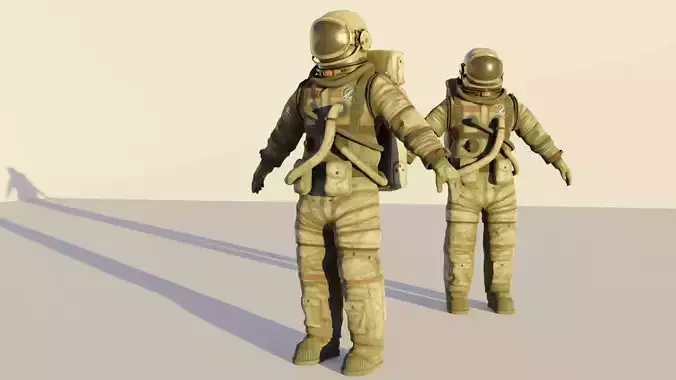1/51
- Outer Shell:
The spacesuit's outer layer is made of a durable and flexible material, often featuring a combination of synthetic fabrics and protective layers to shield astronauts from micrometeoroids and radiation.Textures on the outer shell may include details such as seams, stitches, and panels, adding realism to the model.
- Helmet:
The helmet is a critical component, featuring a transparent visor made of advanced materials to protect against solar radiation and impacts.The 3D model includes a detailed helmet with a sun visor, communications equipment, and a reflective coating to manage heat.
- Life Support Systems:
Various hoses, connectors, and valves are intricately modeled to represent the life support systems integrated into the suit, providing astronauts with breathable air and temperature control.The backpack contains components like a Portable Life Support System (PLSS) and controls for regulating oxygen levels.
- Mobility and Joints:
The 3D model accurately represents the joints and mobility features of the spacesuit, allowing for realistic poses and movements.Articulated joints at the elbows, knees, hips, and other areas enable astronauts to perform tasks in the weightlessness of space.
- Control Panel:
A control panel on the chest or arm of the spacesuit is detailed with buttons, switches, and display screens.Lights and indicators simulate the suit's various functions and status.
- Gloves and Gauntlets:
The gloves are designed for dexterity and tactile sensation, with detailed textures representing grip patterns and material composition.Gauntlets cover the wrists, providing a seamless transition between the gloves and the suit's arms.
- Reflective Materials:
Spacesuits often incorporate reflective materials to manage temperature extremes in space. These reflective layers are accurately represented in the 3D model.
- Communication Devices:#SPACESUIT
Antennas, microphones, and earpieces are modeled to represent the communication devices integrated into the spacesuit for contact with mission control and fellow astronauts.
- Space Insignias and Labels:
Insignias, labels, and mission patches are accurately portrayed on the spacesuit, reflecting the astronaut's affiliation and the purpose of the mission.
- Textures and Detailing:
High-resolution textures are applied to simulate wear and tear, scratches, and other realistic details.Attention to small details, such as reflective strips, zippers, and attachment points, enhances the overall authenticity of the model.
- Animation:
If intended for animation, the 3D model should be rigged to allow realistic movements of the spacesuit's joints and components.
- Realistic Lighting and Rendering:
Proper lighting and rendering techniques are applied to ensure that the spacesuit looks realistic in various lighting conditions.
- Outer Shell:
The outer shell of the spacesuit is constructed from durable, flexible materials capable of withstanding the harsh conditions of space, including micrometeoroids and extreme temperatures.The shell includes layers of protective materials such as reinforced fabrics, Kevlar, and other advanced composites.
- Mobility and Joints:
The 3D model features articulated joints at key areas like the shoulders, elbows, hips, knees, and ankles, allowing astronauts to move and perform tasks with relative ease.Joint mechanisms are accurately represented to simulate the range of motion required for EVAs.
- Life Support Systems:
The spacesuit incorporates life support systems to provide astronauts with oxygen, regulate temperature, and manage humidity levels.Components such as the Primary Life Support System (PLSS), oxygen tanks, thermal control systems, and communications equipment are integrated into the design.
- Helmet and Visor:
The helmet is equipped with a robust visor made from impact-resistant materials to shield the astronaut's eyes from solar radiation and debris.The visor may feature anti-glare and anti-fog coatings for improved visibility during spacewalks.
- Thermal Protection:
The spacesuit includes thermal insulation to regulate the astronaut's body temperature in the vacuum of space.Insulation layers help to prevent heat loss and protect against extreme temperature fluctuations.
- Mobility Enhancements:
The model may include mobility enhancements such as bearings, pulleys, and mechanical counter-pressure systems to assist astronauts in moving and working efficiently in microgravity environments.
- Tool and Equipment Attachments:
The spacesuit features attachment points and storage compartments for tools, equipment, and mission-specific instruments required for EVAs.Harnesses, tethers, and retractable reels are included to secure astronauts and prevent accidental drift in space.
- Reflective and High-Visibility Markings:
Reflective materials and high-visibility markings are incorporated into the design to enhance astronaut visibility during spacewalks and facilitate crew identification.
- Communication Systems:
The spacesuit is equipped with integrated communication systems, including microphones and speakers, to enable clear communication between astronauts and mission control.
- Detailed Textures and Finishes:
Textures and finishes are applied to the model to simulate the appearance of fabric weaves, metallic surfaces, seals, and mechanical components.Surface details such as stitching, straps, zippers, and insignias are meticulously recreated for added realism.
- Scale and Proportions:
The 3D model is created to scale, ensuring accurate proportions and dimensions based on real spacesuit specifications.
REVIEWS & COMMENTS
accuracy, and usability.



















































